
Tobacco and Medicine Menu: 1 2 3 4 5 6 7 8 9 10 11 12 13 14 15 <<First
Tobacco and Medicine During the Golden Age of Piracy, Page 15
Tobacco as Medicine - Use in Compound Medicines
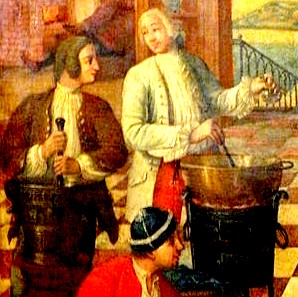
Artist: Michel-Charles Coquelet-Souville
Apothecaries at Work, From Le docteur Claude Morelot
at Hotel-Dieu (1751)
Beginning in the early 17th century, tobacco's reputation as a panacea inspired physicians and apothecaries to use it compound medicines. Some of the new medicines were chemical alterations to tobacco such as Spirit of Tobacco and certain Tobacco Ointments. Others built upon tobacco with the addition of other simple medicines thought to help make the somewhat harsh tobacco more palatable or useful such as Syrup of Tobacco, Conserve of Tobacco and Tobacco Extract. Still others were complex medicines that included tobacco for the treatment of particular health problems such as toothaches, ulcers, parasites and internal problems.
This section looks at several compound medicines described by apothecaries, physicians and surgeons. It begins with those which started with tobacco as their base, then finishes with compounds meant to treat for specific health problems which included tobacco as part of their make-up.
Perhaps the simplest compound of tobacco is Spirit of Tobacco, which relies solely on chemical processing. This appears in George Bate's pharmacopoeia,

An Alembic Explained (Image From Medieval Manuscript)
which was translated into English from Latin by physician William Salmon. Here is Bate's prescription: "It is distill’d as that of Amber, from the dry’d Leaves. Dose a {1 dram to 3 drams} for Vomiting."1
Translator Salmon suggests a slightly more complex recipe: "Rx. Of the best Spanish Tobacco cut small {1 pound} or {16 ounces} put upon it an equal Weight of Flegm of Vitriol [distilled burnt vitriol], put on the Cucurbit or Vesica its Head [a glass retort or still-head with an open bottom that is sealed to the top of heating pot to collect the distillation], digest in Sand for a Day or two; fit to it a Receiver, and distil about ten Ounces of Liquor by a gentle Fire, which keep in a Vial by it self."2 Salmon says this is a good emetic (vomit) and can also be used to bathe the body to eliminate ringworm, scabies and other parasites.
The English author writing the preface to Giles Everard's Triall of Tobacco explains how to process the juice of tobacco, which turns out to be slightly more complex than Bate's Spirit of Tobacco. He says,
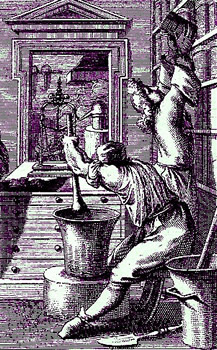
Artist: Caspar Luyken
Apothecary Making a Prescription in a
Large Mortar (1695)
you shall mingle and bruise together the foresaid smaller leaves cut off with the small sprouts and buds of the flowers, (utterly rejecting those two greater leaves at the bottom called Boscheros, as being good for nothing, and unprofitable) and having pressed forth the juice, you shall boyl it in the best sweet strong Spanish Malago [malaga] wine (others adde to it Dants Ale [)], and you shall skim it well, and when it is well purified, you shall put in good store of salt, that the juyce may be as salt[y] as Sea water, then cast in a good quantity of Anni-seed, and Ginger beaten into very small pouder, and let it boyl one hour longer, then let it stand, that the dregs may settle to the bottom, and pour off all that is clear.3
Aniseeds were thought to be good for the digestion (as was tobacco according to some authors) and ginger was said to be hot and dry in the third degree, so it would complement the virtues of tobacco.
Another variation on tobacco was a popular ointment usually referred to as Unguentum Nicotiana. Physician Nicolas Culpeper gives a translation of the Royal College of Physician's [RCP's] 1650 Pharmacopoeia recipe:
Take of Tobacco leaves bruised two pounds, steep them a whole night in red Wine, in the morning boyl it in fresh hogs grease, diligently washed, one pound, till the Wine be consumed, strain it, and add half a pound of juice of Tobacco, Rosin [pine resin] 4 ounces, boil it to the consumption of the juice, adding towards the end round Birthwort [Aristolochia clematitis] roots in powder two ounces; new Wax as much as is sufficient to make it into an Oyntment according to Art.4
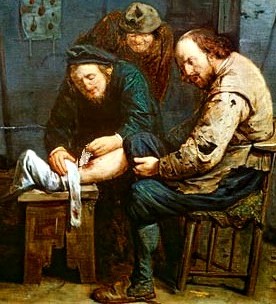
Artist: David Ryckaert
Surgeon Treating a Leg Wound With Medicine (1638)
Culpeper lists a wide variety of health problems this unguent can be used to treat. These include curing "Tumours, Aposthemes, Wounds, Ulcers, Gunshot, Botches, Scabs, Itch, Stinging with Nettles, Bees, Wasps, Hornets, Venemous Beas, Wounds made with poisoned Arrows &c."5 He adds that it is useful in treating scalds, burns, putrefied ulcers, gout, hemorrhoids, sunburn, pimples, headaches, asthma, worms, consumption and blockages in the intestines.6 He elsewhere states, "neither is there any better salve in the world for wounds, than may be made of it; for it cleanseth, fetcheth out the filth though it lie in the bones brings up the flesh from the bottom, and all this it doth speedily"7. Culpeper goes on to state, "It would task a whole Summers day to write the particular virtues of this Oyntment, and my poor Genius is too weak to give it the hundredth part of its due praise."8
Culpeper is not alone in his praise for this ointment. Sea surgeon James Handley recommends Unguent Nicotianæ for use as a mild cauterizing agent in treating callouses in fistulas9. He also employs it as a drying agent to cure ulcers in herpes simplex. Here, he explains that the surgeon is to “fill the Cavity [of the ulcer] by Medicines which strongly dry”10.
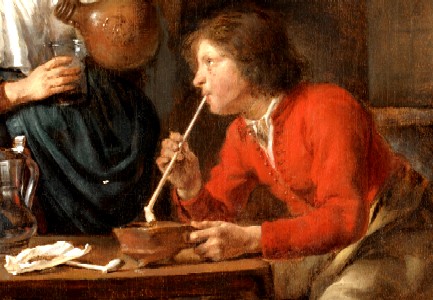
Artist: Gabriel Metsu - A Young Man Smoking (1657)
William Salmon suggested a slightly different version of this ointment than that found in Culpeper, probably based on that found in the RCP's 1711 Pharmacopoeiæ Collegii Regalis Medicorum Londini.
Take Tobacco Leaves {2 pounds}; fresh Hogs-grease Well washed {1 pound} bruise them in a Marble Mortar, and add red Wine {3 ounces} digest them together for a whole Night, then boil it with a gentle Fire, continually stirring of it till the Wine is consumed, strain, and setting it over the Fire again, add clarified Juice of Tobacco {1 pound} Venice Turpentine {4 ounces} boil them again to the consumption of the juice; after add round Birthwort-root in Pouder {2 ounces} yeIlow Wax a sufficient quantity, to make it into an Ointment according to Art.11

Artist: William Sherwin
William Salmon, Wellcome Collection (1671)
Like Culpeper, Salmon praised this ointment as easing all pains of the body, curing bruises, poisoned wounds, putrefied wounds, venomous bites, old sores, ulcers, fistulas, scabs, worms, tumors, apostumes, burns, scalds, asthma, coughs, cholic, intestinal blockages and lung diseases.12
Military surgeon Richard Wiseman suggested the ointment as part of a regime including wine and mercury precipitate for treating an "Ulcer [which] was large, crude and undigested, and the Lips thick, the Parts about the Ulcer pale, and yielding to an impression."13
Not everyone is quite so enamored of this salve, however. Apothecary John Quincy notes in his pharmacopoeia that Unguentum Nicotianum "is constantly kept in the Shops now, but is seldom call’d for, growing yearly more and more into neglect: tho if our English Medley-Writer Salmon may be regarded, it ought for ever to be in the greatest esteem; as he gives it a power in curing almost all Diseases, internal as well as external. It is really matter for good diversion, to read the List of Diseases that Scribler has listed under this trifling Medicine."14
William Salmon was an empirical doctor, basing his conclusions on experience rather than formal training. He may or may not have been educated as a doctor; his training is not clear. However, Quincy was not really a trained as a physician either, being instead an apothecary who practiced medicine in London.
Among the more sticky recipes constructed using tobacco as a base were a conserve, an oxymel (or honey) and a syrup of Nicotianae. George Bate explained the conserve:
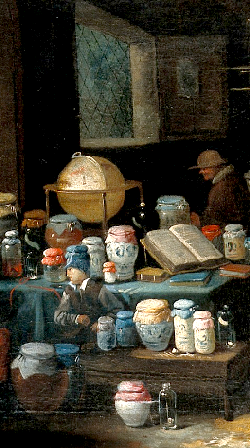
Artist: Egbert van Heemskerck
The Pharmacy, (mid-late 17th century)
Rx Green Leaves of Tobacco {2 pounds} Styrax Calamita [solid styrax] {2 ounces} Cinnamon {1 ounce} Sugar {6 ounces} the best Manna {1.5 pounds} beat them altogether into a Mass, and insolate for forty eight Days. It prevails wonderfully against the Asthma, a suffocative Catarrh. Dose, {½ ounce} every fourth Hour.15
Cinnamon and styrax were both said have a purging ability which would have complemented that attributed to tobacco. Salmon comments that the conserve could be useful given internally "against all Obstructions of the Breast and Lungs, but not a Medicament to be given to every Constitution; for tho' in some strong Bodie's, it will do admirably well; yet in others again it is apt to cause Convulsions."16 He also recommended it for external application in treating gout.
In his 1727 translation of the RCP of Edinburgh's 1722 dispensatory, Peter Shaw explained the recipe for syrup of tobacco:
Take two drams of the leaves of Virginia Tobacco; half an ounce of shav'd Liquorise, and six ounces of boiling Spring-water: let them infuse warm for a night, then strain off the liquor; put to it an equal weight of Honey, and boil it into a Syrup.17
Shaw says in a footnote that tobacco is best known as an emetic (causing vomiting) which is not surprising given that Licorice was also emetic. He that this recipe "is principally intended as an expectorant [something that purges phlegm from the lungs to relieve coughing]; which intention is seconded by the Liquorise and Honey wherewith it is combined."18
The more complex oxymel [honey] of tobacco is found in Thomas Fuller's Pharmacopœia Extemporanea, first published in 1710. It is made thus:
Take Tobacco Leaves (powder'd and tied a Rag) 1 Ounce and half; Agaric likewise tied up) Liquorice, each 1 Ounce; Senna, Raisins of the Sun, each 2 Ounces; Vinegar 2 Quarts; boil to 2 Pints and half, adding, towards the last, Thyme, Hyssop, each 2 Handfuls; Anniseed half an Ounce; Cloves 3 Drams; having strained and clarify’d it, add Honey 1 Pint and half; and then boil it up to a due Consistence.19
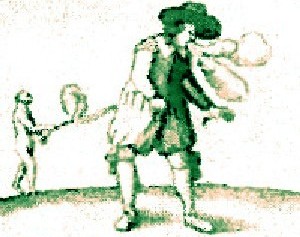
Using Tobacco As a Purge, From The Virtues of Tobacco
Broadsheet (early 17th century)
Like tobacco, agaric, thyme and senna were recognized for their ability to purge phlegm. Cloves, hyssop and vinegar were all said to strengthen the stomach, among other things. Fuller says this honey, given internally, "most excellently and strongly purges, exhausts, deterges, extirpates
the Saburra [decomposed food in the alimentary canal], and Eluvies [floods] of depraved Humours out of the whole Body in general, and the Ventricle and Thorax in particular, and is most accommodated, and specifically peculiar to Ashmatic People."20 However, like the other authors of syrupy tobacco concoctions, he warns that the medical professional must be cautious in administering it, adjusting it based on the age and strength of the patient. "Sometimes (because of the Tobacco) it provokes Vomiting; but then the other Purgers' that are mix'd with Vinegar (which is itself a prime Corrector and Mollifyer) divert its Vehemence, by drawing it downward, and so render it a good and effectual Remedy for pituitous Maladies of the Ventricle and Thorax."21
Bate also includes an extract of tobacco in his list of compound remedies. This sounds simple, but it is actually more complex than most of the previous tobacco-based medicines.

Artist: Egbert van Heemskerck
The Pharmacy, (mid-late 17th century)
Rx. Leaves of out-landish Tobacco {2 ounces} Liquorice {1 ounce} fresh Leaves of Asarabacca [Asarum europaeum or European wild ginger] {10 drams} Aniseeds {3 drams} Coriander {2 drams} Roots of Galingal [Alpinia galanga, from the ginger family], Angelica, {of each, 8 scruples} Hydromel [a mead-like drink] {20 ounces} mix, and digest warm for twenty four hours, then express out the Juice or Humidity, and exhale to a due Consistency. Dose at {2 scruples}.22
Galingal and angelica were both hot and dry in the third degree like tobacco. Licorice and asarabaca were both purges. Bate says that this extract "powerfully purges thick Humors, both by Vomiting and Stool, and is happily given against Asthma’s, and tartarous Obstructions of the Lungs, as also against Fever, chiefly Tertian and Quartans [malaria]; it is profitable against the Jaundice, Dropsy [edema], and Gout."23
Salmon adds that while it works, "you must be sure to provide two or three Quarts of Posset-drink, or Broth, aforehand, before it is Given, and after every Vomit, immediately to cause the Sick to drink three Quarters of a Pint thereof."24 Posset drinks were cream-based, often with sugars, ales or wines and other flavor enhancers like cinnamon or ginger and rose-water, thought to help in treating sick patients.
1,2 William Salmon, Pharmacopœia Bateana, 1713, p. 69; 3 Giles Everard, Panacea, or the Universal Medicine, 1659, p. 20; 4,5 Nicholas Culpeper, Pharmacopœia Londinesis, 1720, p. 226; 6 Culpeper, p. 226-7; 7 Culpeper, p. 33; 8 Culpeper, p. 226; 9 James Handley, Colloquia Chyrurgica, Or the Whole Art of Surgery, 1721, p. 51; 10 Handley, p. 64; 11, 12 William Salmon, Pharmacopœia Londinensis, 1716, p. 661; 13 Richard Wiseman, Of Wounds, Severall Chirurgicall Treatises, 1686, p. 173; 14 John Quincy, Pharmacopoeia Officinalis & Extemporanea, 1719, p. 457-8; 15,16 Salmon, Pharmacopœia Bateana, p. 618; 17 Peter Shaw, The Dispensatory of the Royal College of Physicians in Edinburgh, 1727, p. 113; 18 Shaw p. 114; 19 Thomas Fuller, Pharmacopœia Extemporanea, 3rd ed., 1719. p. 373; 20 Fuller, p. 373-4; 21 Fuller, p. 374; 22,23 Salmon, Pharmacopœia Bateana, p. 281; 24 Salmon, Pharmacopœia Bateana, p. 281-2
Tobacco as Medicine - Use in Compound Medicines - For Specific Health Problems
As explored in previous sections, a wide variety health problems were thought to benefit from tobacco. Several are specifically mentioned by medical authors during the golden age of piracy including problems with the teeth, ulcers, parasites and internal problems. While there are many other health problems that tobacco was supposedly good for treating, these four are included here because they have support from more than one physician or surgeon under study from around the golden age of piracy.
Problems With The Teeth
Tobacco was used to treat several health problems of the teeth. 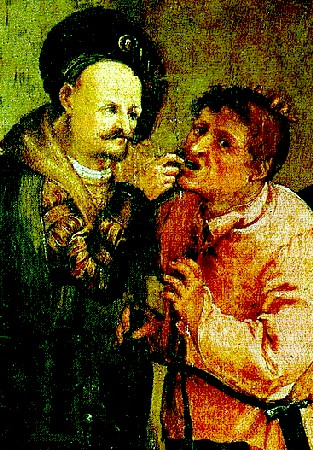
Artist: Johann Liss - Man at the Dentist (c. 1616-7)
The simplest is mentioned by physician John Pechey. He explains, "The Pain of the Teeth is cured, by stopping those that are hollow with Calcin’d [roasted] Tobacco."1
Physicians Thomas Fuller and George Bate each suggest a Odontalgic Tincture for relieving the pain of toothaches. Fuller's prescription is: "Take Roots of Pellitory of Spain half an Ounce; Tobacco cut and dried, Balaustines [pomegranates], of each 1 Dram; Cloves a Dram and half; black Pepper 1 Scruple; Camphire half a Scruple; Hungary [Rosemary] Water 8 Ounces; sharp Vinegar 2 Ounces; extract a Tincture; to which (when filtred) add Liquid Laudanum (not tartariz'd) 2. Drams."2 Even if the tobacco had not effect, the Laudanum (containing opium), camphor and cloves would have helped. Fuller warns his readers not to let the patient swallow the tincture.
Bate's prescription contains many of the same elements, although it is quite a bit more complex than Fuller's.
Rx. Guajacum {2 ounces} Pyrethrum [Pellitory root] {1 ounce} Pomgranate-peels, Galls, Seeds of Henbane and Stavesacre [Delphinium staphisagria or lice-bane], {of each, 1/2 ounce} Cloves, Ginger, Long Pepper, Olibanum [frankincense], {of each, 2 drams} Opium, Camphir, {of each, 1 dram} Indian Tobacco, Sage, Horse-mint [Monarda citriodora], {of each, 2 scruples} S[pirit].V[ini]. {3 gallons} mix, digest, and filter or strain. A little of this is to be held warm in the Mouth, and kept in for a while, then spit out, and reiterated.3
Guaiacum is a curious addition to the prescription. Like tobacco, guaiacum enjoyed a reputation for being good in treating a lot of different health problems in the 17th century. Galls and stavesacre were both said to be useful in treating problems of the teeth and gums. Salmon adds several notes to this, suggesting his own version of the tincture. This shares many of Bate's ingredients, adding a few others as alum, saltpetre, saffron and vinegar. Salmon gives the most explicit instructions on the use of the tincture. "You are to hold it for a while in your Mouth, upon the Place where the Pain is, and after you have spit it out, you must reiterate it, which so long continue ‘till the Pain ceases; which it most effectually accomplishes, tho’ never so acute or sharp, and withal, prevents, after an admirable Manner"4.
Several different prescriptions for treatment of the teeth and gums are found in the surgical book of German military surgeon Matthias Gottfried Purmann. He mentions a water of his own design for toothaches which he says will
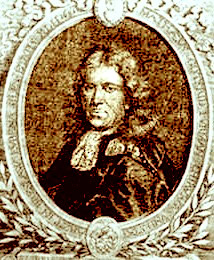
Mathias Gottfried Purmann
"temper the Acrimony, and meliorate the stagnated Humours, as the best and surest way to ease the excessive Pains... [it] has always done me great Service, and seldom or never failed in this Case"5. His prescription is: "Rx. Rasur. [rasped] Lign. Guiac. Rad. Chinæ {of each, 1 ounce} Herb. Nicotian. [tobacco] {1.5 handfuls} Rad. Pyrethri [pellitory root] {2 drams} Caryophill. [cloves] Sem. Hyosciami [henbane seeds] {of each, 1.5 drams} c. s. q. [with a sufficient quantity] Aq. fontan. [spring water] coq. in [boiled in] Colat. [strain] dissolv. Ess[ential]. Anodyn[e]. [a pain reliever] {1 dram} misce [mix] servetur ad usum. [serve for use]"6. Henbane and China roots were said to relieve pain and pellitory roots were specifically prescribed in toothaches. Purmann ends, "This Incomparable Water being taken warm into the Mouth, and held on that side the Mouth where the Pain is, takes it away in a short time"7.
Purmann also gave a prescription for 'spongy gums such as are caused by scurvy' as well as a follow up balsam, each of which contained tobacco leaves.
Rx. Decoct. Fol. Salviæ [sage leaves] & Nicotianæ [tobacco leaves] c. vin. [with wine] {of each, 7 ounces} Tinctura Laccæ [Tincture of Gum Lac, used to strengthen the gums] {4 ounces} Caryophillor. [cloves] {1 dram} Myrrh. {1.5 drams} Syr. flor. tunic. [Syrup of Tunica Saxifraga] Mell. Rosar. [honey of roses] {of each, 3 drams} misce fiat Gargar. [mix to make a gargle] detur in Vitr. [in a glass mortar]
With this you must wash the Gums very well, and then anoint them with the following Balsam.
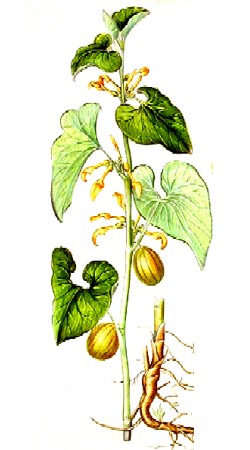
Aristolochia Longa Vulgaris, From Hortus
Eyetettenus, By Basil Bessler (1640)
Rx. Decoct [decoction of] fol. Nicotian. [tobacco leaves] & Aristol[ochia]. Long[a]. Cum Vino [with wine] {8 ounces} rob. Sambuci [congealed juice of elder flowers] Mell. Rosar. [honey of roses] {1.5 ounces} Ung[uent]. Purpur[eum]. W[urzii]. [compound medicine containing henbane, solanum, lettuce, violets and sempervivum, used to sooth pain, soften and refrigerate] {6 drams} Myrrh. in Spir. vin. [spirit of wine] solut. {1/2 ounce} Mell. Veron[icæ]. {3 drams} misce & coque ad consumptionem humiditatus [mix and cook to the consumption of the liquid]; deinde admisce [add and mix] Caryophillor. [cloves] {1.5 drams} Sarcocoll. [gum resin] {2 drams} pulv. Rad. Pyrethr. [powdered pellitory root] {2.5 drams} Succ. Inspissat Hyoscyam [congealed black henbane juice] {1/2 ounce} Laud. Opiat. [laudanum] Sacchar. Saturn. [sugar of lead] ana [of each] {1 dram} m. s. Balsam s. a. [mix into a balsam according to art]8
In addition to tobacco, several simples included in the previous prescriptions for the teeth appear here including henbane, cloves, and pellitory root, all of which were used to assuage pains of the teeth. Myrrh was used in such prescriptions for its ability to fix loose teeth. Purmann comments that although the balsam is difficult to make, "you will think your Pains well bestowed when you come to use it; for it’s very effectual in its Operation, and you will scarce find in the whole Republick of Medicines, any thing that more powerfully resists Putrefaction [rotting], and heals the Gums to a Miracle."9
Purmann also gives a prescription for 'an Excellent Dentifrice', something he used on the boatswain of a ship when he was surgeon in the port town of Strahlsund in then Brandenburg. Purmann explained that the boatswain, Hanss Peterrson, "had a Spongy Excresecence on the lower Part of the Left Side [of his mouth], which happened by the Inartificial drawing of a Tooth, by which the Maxilla [jawbone] was Fissurated."10 He prescribed a mouth rinse:
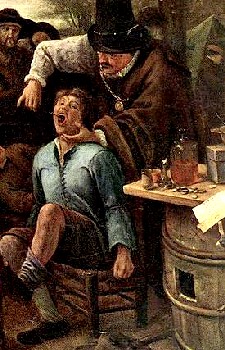
Artist: Jan Steen - The Tooth Puller (1651)
Rx. Rasur. [rasped] Lign.[Bark of] Guiac[um]. {1 ounce} Fol. Nicotiani [tobacco leaves] {1.5 handfuls} Rad. Pyrethr. [pellitory roots] {2 drams} Caryophillor. [cloves] Sem. Hyoscam. [henbane seeds] {of each, 1 dram} Coque in s.q. [cook in a sufficient quantity of] Aqu. commun. [common water] Colat. [let it be strained] Adde Essent. Anodyn. [a pain reliever] {2 scruples} vel [or] Laud[anum]. Liquid. Tartaris {2 scruples} Misce [mix] & Fungo applicetur [may be applied with a fungus].11
This is very much like the water mentioned in his first prescription for a pain-relieving water. He says of this water in this case, "This Excellent Dentifice may be used in many other dolorous Infirmities of the Teeth and Guns, only applying it a little warm. It performed its part very well in this Patient, but yet it would not heal"12.
Purmann's last dental prescription involving tobacco was to be used after a tooth extraction. It is: Rx. Decoct. Fol. Nicotian. Virid. [green tobacco leaves] & Veron[ica]. Cum [with] Aqua mellis [honey water], Chelidon[ium]. [celadine] Persicar[ia]. {of each, 1.5 ounces} coque ad consumptionem humiditarits [cook to the consumption of the fluid], adde Essent. Myrhh {1.5 drams} Mell. Rosar. [honey of roses] {4 scruples} Aloes {1/2 dram} Mercur. Dulc. [sweet mercury] {1 dram} misce fiat Balsamus S. A [mix and make into a balsam according to art]."13 Like tobacco, Veronica was thought to purge phlegm. Celadine was believed to purge choler. Persicaria (specifically knotweed) was said to help stop spitting of blood.
1 John Pechey, The Compleat Herbal, 1707, p. 235; 2 Thomas Fuller, Pharmacopœia Extemporanea, 3rd ed., 1719. p. 504; 3 William Salmon, Pharmacopœia Bateana, 1713, p. 204; 4 Salmon, p. 205; 5,6,7 Matthias Gottfried Purmann, Churgia Curiosa, 1706, p. 81; 8,9 Purmann, p. 80; 10,11,12 Purmann, p. 36; 13 Purmann, p. 104
Ulcers
Ulcers are basically open sores somewhere on (or in) the body. Their healing involves a variety of steps, although it nearly always requires medication. A variety of military surgeons, many of whom also served at sea at some point, mention the topical ointments made with tobacco for use when medicating various kinds of ulcers.

Artist: Adriaen Rombouts
Medicating a Wound on a Man's Back (Late 17th century)
For cleansing ulcers, English military surgeon Richard Wiseman suggested" "Rx. Succ. Nicotianæ [Expressed Tobacco Leaf Juice] {1 pound} picis. resinæ [Pine Resin], ol. olivar. immature. [immature olive oil] {of each, 3 ounces} terebinth. Venet. [Venetian turpentine] {6 ounces} ceræ [Wax] q. s. [a sufficient quantity of wax] fiat Unguentum [make into an unguent]."1 Both pine resin and turpentine were used to soften and cleanse wounds and were often found in medications for healing wounds. This is a nice, simple concoction containing several ingredients that a sea surgeon might have aboard.
Former naval surgeon James Handley suggests a medicine for treating phagedenic ulcers - an ulcer which grows larger over time, due to what we now know are micro-organisms in the wound. Handley recommends that the surgeon "Dress the tumefied [swollen] Brims of the Phagedœnic Ulcer with Unguent. Alb [white unguent] and Popul. [Unguentum Populeon] Mix’d; and the Ulcer it self with Unguent Nicotian {1 ounce} Mercur. Precipitat. Rub. [red mercury precipitate] {2 drams} misce [mixed]."2 Tobacco is known to have the ability to kill living organisms, being used in pesticides, so it should not be surprising that it would work in such a case.
Handley also relies on a medicine containing tobacco leaves to treat ear ulcers believed to be caused by worms. He explains that the presence of worms can be detected by motion in the ears accompanied by 'intolerable itching'. He describes the simple liquid compound as
Nicotiana Rustic Flower, Cambridge Botanic Garden
"a strong Decoction, Ex Cerevis. Non lupulat. [Of Beer Made Without Hops] & fol. Nicotian [tobacco leaves]."3
When treating ulcers caused by herpes exedens (a name given to a form of herpes simplex which has a lot of ulcers), Handley says that if the edges of the ulcer begin to erode, "touch them with Ol. Vitrioli [Oil of Vitriol], or Ol. Sulph [Oil of Sulfur]. Then endeavour to fill up the Cavity by Medicines which strongly dry (yet are not corrosive;) as Ceruss. [White Lead - Lead Carbonate] & Tutiæ preparat. [Zinc Oxide] Cort. Pin. [Pine Bark] Cum Unguent Nicotian [With Tobacco Ointment], & Liniment. Arcei, &c."4 Oil of vitriol (sulfuric acid) and oil of sulfur were both as used to prevent inflammation in open wounds, zinc oxide was used to heal skin and white lead had a drying nature like tobacco.
In a similar vein, German military surgeon Matthias Gottfried Purmann suggests a medicine containing tobacco for hard tumors of the head, neck, shins, and arm joints that accompany syphilis. These were to be opened, have the matter inside squeezed out and be cleansed with a quicklime ointment. Once that is completed, "apply the following Balsam warm upon the Orifice. Rx. Mell. Persicar. [Honey of knotweeds, used to cleanse ulcers] {1/2 ounce} Balsam de Nicotian. Virid. Mei [Tobacco unguent] {3 drams} Copaib[a]. [a stimulant obtained from the trunk of several South American trees, has anti-inflammatory properties] {2.5 drams} Essent Myrrh. [Essence of Myrhh] Sarcocoll. [gum resin] {of each, 1.5 drams} Sacchar. Saturni {Sugar of Lead] {4 scruples} M. f. Balsamus. [make into a balsam]"5 Myrrh and sarcocolla were both used in such applications for it's ability to unite open wounds. Sugar of lead, like white lead, had drying properties similar to tobacco.
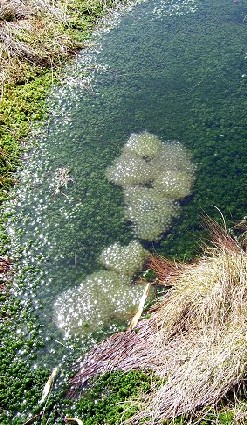
Photo: Richard Webb - Frog Spawn
The most interesting remedy ('interesting' as measured in the amount of time your author spent trying to figure out which it contained) has been saved for last. Purmann provides an astonishingly complex plaster which contains tobacco ash that he used on inveterate (having lasted a long time) ulcers.
Rx. Emplastr. Nigr. Roder. a Castro [Black plaster as made by Rodrigo de Castro] {10 ounces} Spermat. Ranar. [frog spawn] {2 ounces] Ol Amygdal dulc. [Oil of Sweet Almonds] {3 ounces} liquefacta Emplastra cum illo Oleo [dissolve the plaster in that oil] & subducto igne admisce. [and remove from the fire and mix] Pulv. Putamin. Cancror. Spodij. ppt. [Powdered Crab Shell, Prepared] Succin. ppt. [Prepared Amber] {of each, 1 ounce} Osteocoll. [Carbonate of Lime] Tutiæ ppt. [Prepared Zinc Oxide] {of each, 2 ounces} Cort. Ostr. [probably oyster shell] {1.5 ounces} Flor. Antimon. [Trioxide Formed When Antimony is Sublimed] Cinza. [Ash] {of each, 3 ounces} Ocul Cancr. [crab's eyes] {1 ounce} Ciner. Nicotian. [tobacco ash] {1.5 ounces} Terr. Sigillat. [Earth of Lemnos] Matr[ifylva]. [Caprifoliaceae or Honeysuckle] Perlar[gonium]. [Geraminums] ppt. [prepared] {of each, 1/2 ounce} Croc. Metall. Mumiæ [Powdered Mummy] {of each, 1 ounce} Myrrhæ, Aloes Oliban. [Frankicense] {of each, 2.5 drams} Misce [mix] f. c. [make a cataplasm with] s. q. [a sufficient quantity of] Ol. Myrtin. [oil of myrtles] Ad form Emplastri. [to form an emplaster]6
Even Purmann admits that "it is somewhat dear and prolix [takes a long time to make], but will honestly requite your Cost."7 That somehow seems doubtful.
1 Richard Wiseman, Of Wounds, Severall Chirurgicall Treatises, 1686, p. 12; 2 James Handley, Colloquia Chyrurgica Or the Whole Art of Surgery, 1721, p. 65; 3 Handley, p. 78; 4 Handley, p. 64; 5 Matthias Gottfried Purmann, Churgia Curiosa, 1706, p. 198; 6,7 Purmann, p. 204
Parasites

Artist: Gustav Doré
Itching Shipboard, Plate 17, Rhyme of
the Ancient Mariner (1866)
Compound medicines for treating parasites appear in two pharmacopoeias. As mentioned in the previous section when discussing surgeon James Handley's externally-applied phagadenic ulcer treatment prescription, juice extracted from tobacco can be used as an insecticide, so it should not be entirely surprising that they were used to get rid of parasites, sometimes even in the most simple compounds. Handley recommends tobacco leaves mixed with beer to eliminate ear ulcers containing worms.1
George Bate provides a receipt for a medicine called Aqua Herpetic which he recommends as "a Water against Tettars, Ring-worms, Itch [usually a scabies infection], Scabs, Herpes, &c."2 The recipe is:
Rx. Roch Alum [Rock or Roche Alum is made in Italy from alum-stone] {1 ounce} white Vitriol [Zinc Sulfate] {2 ounces} best white Wine-Vinegar {1 gallon} fresh Roots of Elecampane {Inula Helenium] {2 ounces} Leaves of green Tobacco {1 handful} boil to the Consumption of a third Part, strain, and add burnt Vitriol [Impure Iron Sulfate] {1/2 ounce} mix, and keep for use. Cloths, being wet in a sufficient Quantity of this Water, are to be laid upon the Herpes, and permitted to dry on, four Times, viz. ‘till (the Scabs yet sticking on) a new Skin be generated underneath.3
Alum was known to help with the Itch. In addition to Bate's recommendations for use, interpreter William Salmon adds that a woman who regularly used the water told him "that it will take away Lentils, Freckles, Pimples, Sun-burning, Tannings, and such like Deformities."4 He also says that parts affected can be bathed in the water several times a day, "but then you must be sure to let it be always very hot when you use it, so will it do five Times more good than if you should use it cold; because hot, it the better opens the Pores, and penetrates the Skin."5

Photo: Andre Karwath -
Polypodium Vulgare
Nicolas Culpeper includes a prescription for Syrupus Scabiosæ [Syrup of the Scabious] from the College of Physicians pharmacopoeia noting that "it is taken ...with good success by such as are Itchy or Scabby."6 The recipe for this is:
Take of the Roots of Elecampane and Polypodium of the Oak, of each two ounces, Raisins of the Sun stoned an ounce; Sebestens [Cordia Sebestena Fruit] twenty; Coltsfoot [Tussilago farfara], Lungwort, Savoury, Calaminth[a], of each a handful and an half; Liquorice, Spanish Tobacco, of each half an ounce; the seeds of Nettles, and Gotton [Cotton?], of each three drams, boil them all (the roots being infused in white Wine the day before) in a sufficient quantity of Wine and Water to eight ounces; strain it, and adding four ounces of the juice of Scabious, and ten ounces of Sugar, boil it to a Syrup adding to it twenty drops of oyl of Sulphur.7
Although the name suggests that this concoction is for use with parasites, Culpeper primarily suggests it as "a cleansing Syrup appropriated to the Breast and Lungs; when you perceive them oppressed by Flegm, Crudities or Stoppings, your remedy is to take now and then a spoonful of this Syrup"8. Unlike Bate's water, this medicine appears to be taken internally for treating parasites.
In addition to these two entries, Woodes Rogers mentions in the journal of his privateering voyage begun in 1709 that the natives of Brazil use tobacco to treat parasites. "The Medicines, which the Missionaries give against Worms, is a Vomit of Tobacco-Leaves; and after that, four Lemon-Juice with those of Mint and Rue put into Milk."9
9 James Handley, Colloquia Chyrurgica, Or the Whole Art of Surgery, 1721, p. 78; 2 William Salmon, Pharmacopœia Bateana, 1713, p. 13; 3 Salmon, p. 13-4; 4,5 Salmon, p. 14; 6,7,8 Nicholas Culpeper, Pharmacopœia Londinesis, 1720, p. 122; 9 Woodes Rogers, A Cruising Voyage Round the World, 1712, p. 85
Internal Problems
Remedies containing tobacco are suggested for some internal problems in books during the golden age of piracy, probably being a holdover from tobacco's earlier reputation as a panacea.
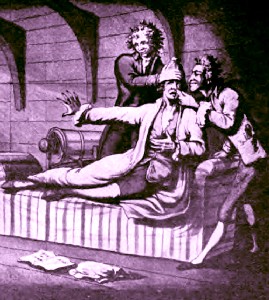
Artist: Thomas Rowlandson
Ill Man Shipboard, From
The British Tar in Fact and
Fiction, p. 254 (1800)
George Bate describes a water called Aqua Pneumonica which he describes as 'a Water expelling Wind'. He further explains that it is good when treating "the Cholick [obstructions of the intestinal system], excrutiating Pains of the Stomach, want of Appetite, &c"1. The prescription is: "Rx Leaves of the best Tobacco, outward Rind or Peel of Oranges, {of each, 4 ounces} Winter-Cinnamon [Canella winterana, a substitute for cinnamon] {6 drams} Aniseeds {1.5 ounces} Spanish Wine {1.5 gallons} Spirit of Wine {1 gallon} digest and distil in a glass Still."2 Aniseeds and cinnamon were both recommended in digestive track problems.
Physician John Pechey included a very simple topic remedy to be used in treating palsy, paralysis which is often accompanied by tremors. "Take the green Leaves [of tobacco], and infuse them in Malaga-Wine, and rub the Parts well with it after Sweating."3
Physician Thomas Fuller suggests two different tobacco medicines for internal problems. The first is for catarrhs (a build up of mucus in the nose and/or throat). "Take Pistachio Peel: 6 Drams; Tobacco 2 Drams; Colts-foot [Tussilago] 1 Ounce; Oil of Anniseed 8 Drops; cut and mix."4 Fuller goes on to note, "Taken in a Pipe like Tobacco, it's good to stop a Catarrh, and prevent a Consumption [wasting disease such as tuberculosis]."5
Fuller suggests another compound tobacco specifically for treating consumption which shares several of the same ingredients as his other recipe, as well as adding some new ones.
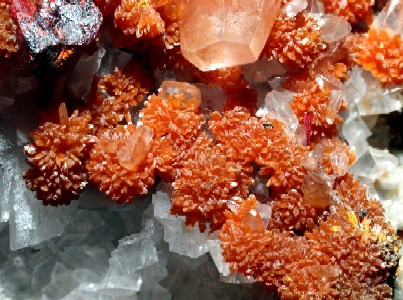
Photo: Géry Parent - Auripigment or Orpiment (Arsenic Sulfide Mineral)
Take Pistachio Peels 3 Drams; dry'd Hyssop, white Horehound, Rosa Solis, each two Drams; Auripigment [Arsenic Sulfide Mineral], Tobacco, each half an Ounce; reduce all into an exquisitely fine Powder; which grind upon a Marble with Yolk of Egg, till it become like Painters Paint. This lay upon the rough side of Coltsfoot Leaves with a Pencil or Knife, and hang them by, single: When they are dry, cut them with Scissors fit for a Pipe.6
Like the previous medicine, this was to be smoked "like Tobacco, Morn and Even, and as you are smoaking draw it into the Lungs with your Breath, and cough it out again."7 Fuller adds that English physician Thomas Willis said that some empirical physicians "ordinarily prescribe Smoaking of Orpiment [Auripigment] like Tobacco; and sometimes with good Success. And it's a Practice with the common People, to smoak Bits of Cloth painted with Orpiment (such as we find us'd for Hangings in some old Houses) and suck it into, their Lungs, for a Cure of Consumptions."8
1,2 William Salmon, Pharmacopœia Bateana, 1713, p. 123; 3 John Pechey, The Compleat Herbal of Physical Plants, 1707, p. 235; 4,5,6,7,8 Thomas Fuller, Pharmacopœia Extemporanea, 3rd ed., 1719. p. 507

